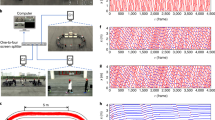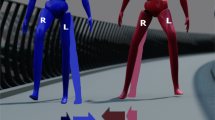Footbridges start to sway when packed with pedestrians falling into step with their vibrations.
Abstract
Soon after the crowd streamed on to London's Millennium Bridge on the day it opened, the bridge started to sway from side to side: many pedestrians fell spontaneously into step with the bridge's vibrations, inadvertently amplifying them. Here we model this unexpected and now notorious phenomenon — which was not due to the bridge's innovative design as was first thought — by adapting ideas originally developed to describe the collective synchronization of biological oscillators such as neurons and fireflies. Our approach should help engineers to estimate the damping needed to stabilize other exceptionally crowded footbridges against synchronous lateral excitation by pedestrians.
This is a preview of subscription content, access via your institution
Access options
Subscribe to this journal
Receive 51 print issues and online access
$199.00 per year
only $3.90 per issue
Buy this article
- Purchase on Springer Link
- Instant access to full article PDF
Prices may be subject to local taxes which are calculated during checkout


Similar content being viewed by others
References
Dallard, P. et al. Struct. Eng. 79, 17–33 (2001).
Dallard, P. et al. J. Bridge Eng. 6, 412–417 (2001).
McRobie, A., Morgenthal, G., Lasenby, J. & Ringer, M. Proc. Inst. Civ. Eng. Bridge Eng. 156, 71–79 (2003).
Roberts, T. M. Proc. Inst. Civ. Eng. Bridge Eng. 156, 155–160 (2003).
Newland, D. E. Proc. Inst. Mech. Eng. 218, 477–492 (2004).
Nakamura, S. J. Struct. Eng. 130, 32–37 (2004).
Glass, L. & Mackey, M. C. From Clocks to Chaos: The Rhythms of Life (Princeton Univ. Press, Princeton, 1988).
Winfree, A. T. The Geometry of Biological Time 2nd edn (Springer, New York, 2001).
Kuramoto, Y. Chemical Oscillations, Waves and Turbulence (Springer, Berlin, 1984).
Strogatz, S. H. Physica D 143, 1–20 (2000).
Author information
Authors and Affiliations
Corresponding author
Ethics declarations
Competing interests
The authors declare no competing financial interests.
Supplementary information
Supplementary Information
(PDF 216 kb)
Rights and permissions
About this article
Cite this article
Strogatz, S., Abrams, D., McRobie, A. et al. Crowd synchrony on the Millennium Bridge. Nature 438, 43–44 (2005). https://doi.org/10.1038/438043a
Published:
Issue Date:
DOI: https://doi.org/10.1038/438043a
This article is cited by
-
A 5M Synchronization Mechanism for Digital Twin Shop-Floor
Chinese Journal of Mechanical Engineering (2023)
-
Modelling physical contacts to evaluate the individual risk in a dense crowd
Scientific Reports (2023)
-
The seasons within: a theoretical perspective on photoperiodic entrainment and encoding
Journal of Comparative Physiology A (2023)
-
Spontaneous gait phase synchronization of human to a wheeled mobile robot with replicating gait-induced upper body oscillating motion
Scientific Reports (2022)
-
Pedestrian-Induced Bridge Instability: The Role of Frequency Ratios
Radiophysics and Quantum Electronics (2022)
Comments
By submitting a comment you agree to abide by our Terms and Community Guidelines. If you find something abusive or that does not comply with our terms or guidelines please flag it as inappropriate.



